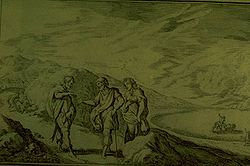
Erysichthon
Encyclopedia

Greek mythology
Greek mythology is the body of myths and legends belonging to the ancient Greeks, concerning their gods and heroes, the nature of the world, and the origins and significance of their own cult and ritual practices. They were a part of religion in ancient Greece...
, Erysichthon (also spelled Erisichthon, both of which translate as "Earth-tearer") can refer to two different personages:
Erysichthon of Thessaly
King Erysichthon of ThessalyThessaly
Thessaly is a traditional geographical region and an administrative region of Greece, comprising most of the ancient region of the same name. Before the Greek Dark Ages, Thessaly was known as Aeolia, and appears thus in Homer's Odyssey....
was the son of Triopas
Triopas
In Greek mythology, Triopas, Triophas or Triops was the name of several characters, whose relations are unclear. He belonged to the house of Phoroneus....
. He cut down trees in a grove, sacred to Demeter
Demeter
In Greek mythology, Demeter is the goddess of the harvest, who presided over grains, the fertility of the earth, and the seasons . Her common surnames are Sito as the giver of food or corn/grain and Thesmophoros as a mark of the civilized existence of agricultural society...
; and cutting it down he killed a dryad nymph. Demeter punished him by placing Limos
Limos (mythology)
In Greek mythology, Limos was the goddess of starvation. She was opposed by Demeter, goddess of grain and the harvest with whom Ovid wrote Limos could never meet, and Plutus, the god of wealth and the bounty of rich harvests...
, unrelenting and insatiable hunger
Hunger
Hunger is the most commonly used term to describe the social condition of people who frequently experience the physical sensation of desiring food.-Malnutrition, famine, starvation:...
, in his stomach. He sold all his possessions, including his daughter, Mestra
Mestra
In Greek mythology, Mestra She is also occasionally referred to as Mnestra in modern sources, though the form is not anciently attested; cf. Clytemnestra, whose name does appear with and without the n in ancient authors...
, to buy food, but was still hungry. Mestra was freed from slavery by Poseidon
Poseidon
Poseidon was the god of the sea, and, as "Earth-Shaker," of the earthquakes in Greek mythology. The name of the sea-god Nethuns in Etruscan was adopted in Latin for Neptune in Roman mythology: both were sea gods analogous to Poseidon...
, who gave her the gift of shape-shifting to escape her bonds. Erysichthon sold her numerous times to make money to feed himself. Eventually, Erysichthon ate himself
Self-cannibalism
Self-cannibalism is the practice of eating oneself, also called autocannibalism, or autosarcophagy. A similar term which is applied differently is autophagy, which specifically denotes the normal process of self-degradation by cells...
in hunger.
Erysichthon of Attica
There was another Erysichthon, the son of King CecropsCecrops
This name may refer to two legendary kings of Athens:* Cecrops I* Cecrops IIIt more often refers to Cecrops I, who was the better known....
I of Athens
Athens
Athens , is the capital and largest city of Greece. Athens dominates the Attica region and is one of the world's oldest cities, as its recorded history spans around 3,400 years. Classical Athens was a powerful city-state...
and Agraulus. He died childless during his father's reign. He was said to have died in Prasiae (modern Porto Rafti
Porto Rafti
Porto Rafti , official name: Limēn Mesogaias or Limani Mesogaias , is a seaside town.In 2001, its population was 7,131. It surrounds the Porto Rafti Bay in the east coast of Attica, 38 km from the center of Athens, Greece...
), on the east coast of Attica, as he was returning from the holy island of Delos
Delos
The island of Delos , isolated in the centre of the roughly circular ring of islands called the Cyclades, near Mykonos, is one of the most important mythological, historical and archaeological sites in Greece...
with a statue of Eileithuia, Goddess of Childbirth. Of the three ancient wooden images of the goddess that could be seen at her temple at Athens,
one was identified as the image that Erysichthon had brought from Delos. According to Pausanias, Erysichthon’s tomb could be seen at Prasiae, where his corpse was said to have been buried after his ship had arrived in port.

